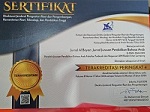Various Forms and Meanings of Diminutive in Classical and Modern Arabic
Abstract
Keywords
Full Text:
PDFReferences
Abderahman, Wajih Hamad. "A Linguistic Study of The Impact of English on Arabic Word-Formation”. Islamic Studies. Vol. 34. No. 2. (1995) : 223-231.
Abu-Haidar, J.A “The Diminutives in the "Dīwān" of Ibn Quzmān: A Product of Their Hispanic Milieu?”.Bulletin of the School of Oriental and African Studies, Vol. 52. No. 2. (1989) : 239-254.
Abu-Mughli, Samih. Fiqhu l-LughatiwaQadaya l-Arabiyya. Amman : Majdalawi Press, 1987.
Al-Ghalayini, Mustafa. Jami’u d- Durusi l-‘Arabiyya Vol.1. Sayda. Al-Maktabatu l-Asriyya, 1971.
Al-Jabiri, Muhammad Abid. Bunyat al-Aql al-Arabi: Dirasat Taḥlīliyyah Naqdiyyah li Nuḑum al-Ma’rifah fi al-Tsaqōfah al-Arabiyyah. Beirut : Markaz Dirasat al-Wahdat al-Arabiyyah, 2009.
Al-Khuli, Muhammad Ali. A Dictionary of Theoretical Linguistics: English-Arabic with An Arabic-English Glossary. Beirut : Libraire Du Liban, 1982
Al-Iryani, M. Al-mu‘jam al-yamany al-lughat wa-t-turath. Damascus: Dar al-Fikr, 1996.
Al-Rojaie, Y. Diminutives in Najdi Arabic: An account of socio - pragmatic variation. Journal of Human and Administrative Sciences, Vol. 1. No. 2. (2012) : 5-35.
Alshboul, Sabri “Default Diminutive: Evidence from Modern Arabic Standard”, Journal of Language Teaching and Research, Vol. 4. No.1. (2013) : 21-26.
Allan, K. and Salmani Nodoushan, M. A. Pragmatics : The State of the Art. International Journal of Language Studies. Vol. 9. No. 3. (2015) : 147-154
An-Nailah, Abdul-Jabbar A. As-Sarfu l-Wadih. Mosul: Mosul University Press, 1988.
As-Sālih, Subhi DirāsātunFīFiqhi l – Lugha. Beirut: Daru l –Malayīn, 1960.
Aziz, Yowell Y. "Modes of Address in English Arabic Translation" Babel, No. 3. Vol. xxx1, (1985) : 144-146.
Badarneh, Muhammed A. The Pragmatics of Diminutives in Colloquial Jordanian Arabic. Journal of Pragmatics Vol. 42. No. 1 (2010) : 153-167
Bat-El, O. Stem modification and cluster transfer in Modern Hebrew. Natural Language and Linguistic Theory. Vol. 12, 571–596.
Bauer, Laurie. Evaluative morphology: in search of universals. Studies in Language Vol. 21 No. 3, (1997) : 533-575.
Benyoucef, R., & Mahadin, R. Phonological processes in Algerian Arabic as spoken in Mostaganem: An optimality perspective, Research on Humanities and Social Sciences, Vol. 3 No. 14, (2013) : 85-100
Crystal, David. A Dictionary of Linguistics and Phonetics. Oxford. Basil Blackwell Ltd, 2008.
Dahl, O . Diminutives and augmentatives. In K. Brown (Ed.), The encyclopedia of language and linguistics (Vol. 3, 2nd ed. pp. 594–595). London: Elsevier, 2006
Davis, S., & Zawaydeh, B. (1999). A descriptive analysis of hypocoristics in Colloquial Arabic. Language and Linguistics, Vol. 3, 83–98.
Dawood, Mohammed. &Farhan, Zuhair "Aspects of Lexical Development in Modern Standard Arabic "Ādābu- rRāfidayn, Vol. 20, (1989) : 39-52.
Dressler, W., &Merlini Barbaresi, L. Morphopragmatics of diminutives and augmentatives: on the priority of pragmatics over semantics. In I. Kenesei& R.M. Harnish (Eds.), Perspectives on semantics, pragmatics and discourse: a festschrift for Ferenc Kiefer (43–58). Amsterdam: Benjamins, 2001.
Fontein, A.M. &Pescher. A. Nederlandse Grammaticavoor Anderstaligen. Utrecht. Nederlandse Centrum Buitenlanders, (1985).
Fayez, E. Siibawaih’s linguistic analysis of the diminutive in Classical Arabic and its subsequent developments (Published doctoral thesis). USA : Georgetown University, (1990)
Gafos, A. I. An argument for a stem-based view of Arabic morphology: doubled verbs revisited. In D. B. Parkinson, & E. Benmamoun (Eds.), Perspectives on Arabic Linguistics. Vol. 13–14. Amsterdam: Benjamins. (2002) : 59–86.
Hamid, Iman, Sahar Faiq. “A Comparative Study of Diminutive Forms in English and Arabic”Journal of Education and Science, Vol. 16 No. 1, (2009) : 1-15.
Ibrahim, A. Noun formation in Standard English and Modern Standard Arabic: A contrastive study, Journal of Language Teaching and Research, Vol. 1 No. 5, (2010) : 614-623.
Ibrahim, Hisham "Pronouns and Forms of Address in Iraq" Journal of the College of Teachers, Vol. 36, (2003) : 20-32.
Ibrahim, Yousef, “Diminutive in Najdi Arabic : An account of socio-pragmatic variation”. Journal of Human and Administrative Sciences. Vol. 1, (2012) : 9-35
Ismail, A. The diminutive in Modern Standard Arabic: An optimality theoretical analysis, Canadian Social Science, Vol. 8 No. 2, (2012) : 187-196.
Katamba, F. Morphology. London. Macmillan Press, 1993.
Kharma, Nayif & Hajjaj, Ali. Errors in English Among Arabic Speakers: Analysis and Remedy. London: Longman Group Ltd, 1989.
Kridalaksana, H. Kamus Linguistik. Jakarta. Gramedia Pustaka Utama, 2008.
Laalo, K. Diminutives in Finnish child-directed and child speech: Morphopragmatic and morphophonemic aspects, Psychology of Language and Communication, Vol. 5. No.2, (2001) : 71-80.
Lahrouchi, Mohammed and Ridouane Rachid. On Diminutive and Plural in Moroccan Arabic. Vol. 26. No.4, (2016) : 453-475
Lee, S. Repair strategies in labial dissimilation: Diminutive formations in Xitsonga, Stellenbosch Papers in Linguistics Plus, Vol 44, (2014) : 89-103.
Maalej, Zouhair. Addressing non-acquaintances in Tunisia Arabic : A cognitive Pragmatic Account”, Intercultural Pragmatic Vol. 7. (2010) : 147-173.
Mahadin, Radwan S. “Noun Diminutive Formation in Algerian Arabic as Used in Jijel: An Optimality Analysis” International Journal of Humanities and Social Science Vol. 5, No. 12 (December 2015).
Mahmood,K M. Eshreteh, A Pragmatic Analysis of Diminutives in Palestinian Society. International Journal of Language Studies. Vol. 11, No. 1. (January 2017) : 45-62.
Masliyah, S. The Diminutive in Spoken Iraqi Arabic. Journal of Arabic Linguistic. Vol. 33, (1997) : 68-88.
Nakshabandi, A. Diminutives in Classical Arabic and The Urban Hijazi Dialect. Linguistic Communication Periodical. Vol. 7, (1996) : 1- 15.
Rashid, B.. Optimality of diminutive forms in Modern Standard Arabic, Journal of Basrah Researches (Humanities Series), Vol. 34 No, (2010) : 121-138.
Ratcliffe, R. Prosodic templates in a word-based morphological analysis of Arabic. In M. Eid, & Ratcliffe R. R. (Eds.), Perspectives on Arabic Linguistics 10. Amsterdam: Benjamins, 1997.
Rojih, Abduh At-TațbīqaṢ-ṣorfiy. Beirut : Dar Nahdah Arabiyah, 1999.
Salmani Nodoushan, M. A. Review of Philosophical Perspective for Pragmatics. Linguistic Online, Vol. 58. No. 1, (2013) : 119-126
Schneider, K. The truth about diminutives, and how we can find it: Some theoretical and methodological considerations, SKASE Journal of Theoretical Linguistics, Vol 10. No.1, (2013), 137-151.
Shetter, William Z “The Dutch Diminutive”. The Journal of English and Germanic Philology. Vol. 58, No. 1 (1 Jan 1959) : 75-90.
Sībawaih, Amru. Al-Kitab. Vol III. Beirut. Dār al-Kutub al-Ilmiyyah, 1999.
Sifianou, M. The Use of Diminutives in Expressing Politeness : Modern Greek vs English. Journal of Pragmatics. Vol. 17, 1992 : 155-173
Sudaryanto. Metode dan Aneka Teknik Analisis Bahasa: Pengantar PenelitianWahana Kebudayaan secara Linguistis. Yogyakarta. Duta Wacana University Press, 1993.
Taine-Cheikh, Catherine Expressiveness and evaluation in Arabic: the singular development of the diminutive in Ḥassāniyya Arabic. Studies in Language,John Benjamins Publishing. Vol. 42 No. 1, (2018) : 81-113.
Travis. C. E The Ethnopragmatics of the Diminutives in Conversational Colombian Spanish. Intercultural Pragmatics. Vol.1 No. 2, (2004) : 249-274
Ussishkin, A. P. The inadequacy of the consonantal root: Modern Hebrew and output–output correspondence. Phonology, Volume 16, (1999) : 401–442.
Vycichl, Werner Diminutiv und Augmentativ im Berberischen. ZDMG. Vol. III No.2, (1961) : 243-253.
Watson, Janet “Arabic Morphology: Diminutive Verb and Diminutive Noun in San’ani Arabic”. Morphology, 2006
Wright, William. A Grammar of the Arabic Language. Cambridge. CUP, 1971.
Wierzbicka, Anna Diminutives and depreciatives: semantic representation for derivational categories. Quaderni di semantica Vol. V, No. 1, (1984) : 123-130
Yassin, M. Aziz F. Personal names of address in Kuwaiti Arabic. Anthropological linguistics. Vol. 20 No.1, (1978) : 53-63.
Al-Andalusi, Ibn Hazm. Tauq al-Hamamah. Beirut : Darul-Kutubi llmiyyah, 2010.
Al-Fayrūzabadi, al-Qāmūs al-Muḥīț. Beirut. Daru l-Kutubi l-Ilmiyyah, 2009.
Al-Manẓur, Ibnu. Lisan al-Arab. Kairo : Dar al-Hadits, 1990.
Al-Mutanabbi, Abi Tayyib. Dīwān al-Mutanabbi. Beirut : Darul-Kutubi l-Ilmiyyah, 1987.
Ma’luf, Louis. al-Munjid Fi al-Lughati wal I’lam. Beirut : Dar Nahdah Arabiyah, 1990.
DOI: http://dx.doi.org/10.24042/albayan.v12i2.6349
Refbacks
- There are currently no refbacks.
Copyright (c) 2020 Jurnal Al Bayan: Jurnal Jurusan Pendidikan Bahasa Arab
License URL: https://creativecommons.org/licenses/by-sa/4.0
Editorial Office:
Jurnal Al Bayan: Jurnal Jurusan Pendidikan Bahasa Arab, Arabic Education Study Program, Faculty of Education and Teachers Training, Unversitas Islam Negeri Raden Intan Lampung
Jl. Endro Suratmin 1 Sukarame, Bandar Lampung 35131-Indonesia
e-mail: jurnalalbayan@radenintan.ac.id
http://ejournal.radenintan.ac.id/index.php/albayan/index
Jurnal Al Bayan: Jurnal Jurusan Pendidikan Bahasa Arab is licensed under a Creative Commons Attribution-ShareAlike 4.0 International License. p-ISSN 2086-9282 | e-ISSN 2549-1229









